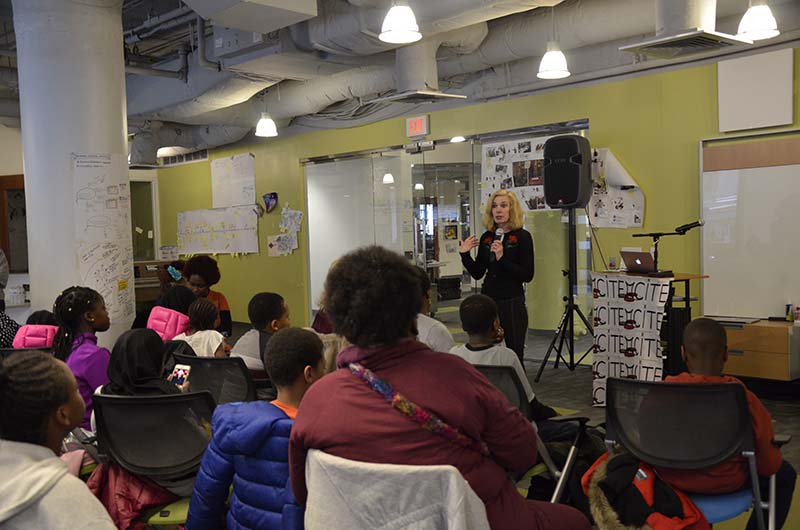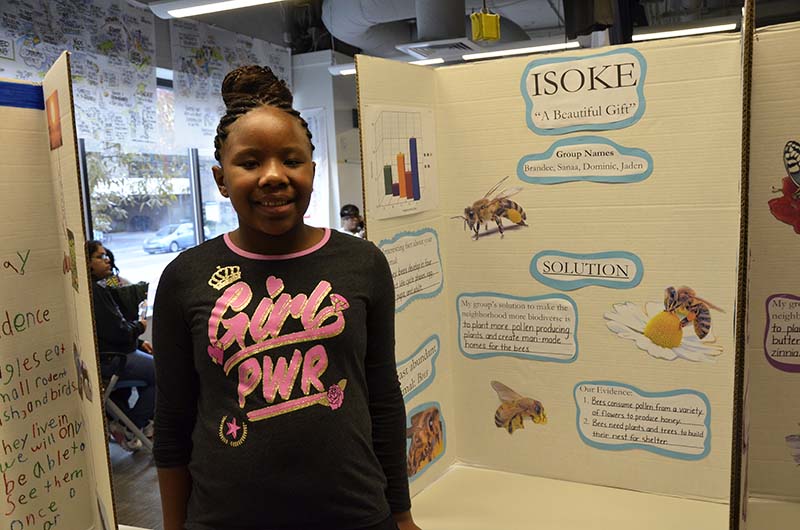West Philadelphia Kids Become Philly Scientists With Drexel Biodiversity Project

- Dragons Deliver: Drexel’s Annual Holiday Drives Support Military and Local Families
- Drexel Environmental Collaboratory Releases Cross-Sector Findings on Severe Weather Recovery Challenges
- How and When Could AI Be Used in Emergency Medicine?
- Video Game Design Reaches New Heights in 'Skyscraper Games'

This fall, children attending grades four through six at schools in Mantua, Powelton and West Philadelphia learned about science not at their chairs or desks, but outside in parking lots, gardens, playgrounds and other spots in their neighborhoods. The students examined and recorded the biodiversity of their community, taking their evidence and creating posters to present their evidence-based solutions to promoting biodiversity in the area. Like most school projects, that final poster was presented to their teachers and family members, but also Academy of Natural Sciences of Drexel University scientists, Drexel University researchers and representatives from the City of Philadelphia and the School District of Philadelphia. Some of the proposed changes — like planting more trees and flowers — could even be actualized.
It’s all part of a three-year, $1.17 million grant that the National Science Foundation awarded to a team of Drexel researchers in 2016. Led by the School of Education’s Distinguished University Professor Nancy Songer, PhD, who served as the principal investigator, the team created a professional animal tracking app and developed a curriculum plan that was implemented in science classrooms and after-school programs at Belmont Charter School and Martha Washington Elementary Schools. About 45 students participated in the project, which is called “Philly Scientists,” over the course of four weeks this past fall.
For the project, iPads with the special app created by Andy Stutzman and his team associated with the ExCITE Center were given to the students to use to take a picture of a creature they found and describe what they saw. They were also tasked with noting what group it belongs in, where its microhabitat was, where they saw it and what it was doing. Scientists from the Academy of Natural Sciences were also involved to help identify creatures and show how the work that the students were doing resembled what scientists can do in real life.

The students worked in groups to learn about a specific animal or plant — from birds to butterflies to spiders — and describe its food chain and habits, as well as offer a solution to improve the biodiversity of the neighborhood to make it more attractive to the animal. The teams displayed their findings on a poster and presented them to not just their teachers, but also their families, Drexel researchers and city planners at the “Philly Scientists Summit” held at Drexel’s ExCITe Center on Dec. 8. The goal was to help the city planners understand what plant and animal life is in the area, which could help guide future development decisions.
“Next-generation science standards have a strong emphasis on having people apply some of their scientific knowledge,” said Songer. “We’ve taken those next-generation ideals and manifested it into curriculum. That’s why the students were asked to come up with evidence-based solutions, and were able to present their findings to city planners. We wanted to help the students see that their knowledge is usable and could be implemented in real life.”
Sanaa Ward, a fourth-grade student at Belmont Charter who researched bees for Philly Scientists in her school and her after-school program, said she would continue to keep an eye out for the animals and plants in her community even after the project finished.
“My favorite part of the project was when we went outside and found worms and centipedes,” she said. “I’m going to keep learning about bugs by going around the neighborhood.”
Brandone Roberts, Ward’s fourth-grade teacher at Belmont Charter, said she restructured her class’s science curriculum to incorporate the Philly Scientists project.

“It really helped the kids so they could learn from it,” she said. “They learned how to calibrate and correlate a lot of data.”
The Drexel team also learned from the experience, working with the students and being on call to help with promotional materials, techshoot app problems and engage in learning opportunities.
“Something I really enjoyed doing was participating in this kind of outreach, especially minority and underserved community outreach, and helping to instruct science education using technology,” said Guillermo Ibarrola, a PhD doctoral candidate in STEM education in the School of Education who was involved with the project.
Though it was a bit tricky to find many examples of biodiversity in the fall and winter, Roberts said that she hopes to integrate the curriculum into next year’s class, and hopefully teach it in the spring. Songer and her team also hope to expand the project so that it runs this spring, where it will be used at the Samuel Powel School for the second spring in a row, and that it could even be used after the grant ends. In the spring, the team will start considering what proposals will be enacted.
In This Article
Drexel News is produced by
University Marketing and Communications.
